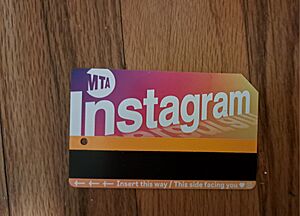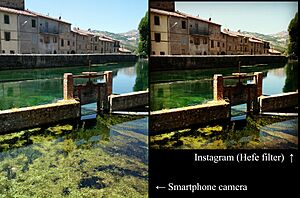Instagram facts for kids
  |
|
| Original author(s) | |
|---|---|
| Developer(s) | Meta Platforms |
| Initial release | October 6, 2010 |
| Operating system |
|
| Available in | 33 languages |
|
List of languages
|
|
| License | Proprietary |
Instagram is a popular American social media app for sharing photos and short videos. It is owned by Meta Platforms, the same company that owns Facebook. Users can upload photos and videos, edit them with filters, and organize them with hashtags. You can also tag your location to show where you were.
Posts can be shared with everyone or just with followers you approve. You can explore other people's posts by searching for tags and locations. You can also "like" posts and follow other users to see their content in your personal feed. Instagram is available on phones, computers, and web browsers.
When Instagram first started, all photos had to be in a square shape. This was to match the screen of the iPhone at the time. In 2015, they changed this rule to allow for different photo sizes. The app also added messaging, the ability to post multiple photos at once, and a "Stories" feature. Stories let you post photos and videos that disappear after 24 hours, similar to its competitor, Snapchat.
Instagram was created by Kevin Systrom and Mike Krieger and launched in October 2010. It became very popular very quickly. It had one million users in just two months and reached one billion users by June 2018. In 2012, Facebook bought Instagram for about $1 billion. While many people love Instagram, it has also faced criticism for how it affects the mental health of teenagers and for its policy changes.
History of Instagram
Instagram started in San Francisco as an app called Burbn. It was created by Kevin Systrom and Mike Krieger. They realized Burbn was too much like another app, Foursquare. So, they decided to focus on photo-sharing, which was a popular feature. They renamed the app Instagram, which is a mix of the words "instant camera" and "telegram."
2010–2011: The Beginning
The very first Instagram post was a photo of South Beach Harbor. It was posted by Mike Krieger on July 16, 2010. The Instagram app for iOS was officially released on the App Store on October 6, 2010. The app quickly gained many users and investors.
2012–2014: Growing Bigger
On April 3, 2012, Instagram released an app for Android phones. It was downloaded over a million times in less than a day. Just a few days later, on April 9, Facebook, Inc. (now Meta Platforms) bought Instagram for $1 billion. Facebook's CEO, Mark Zuckerberg, said that Facebook would help Instagram grow but keep it as a separate company.
In November 2012, Instagram launched website profiles. This allowed people to see user feeds on a web browser.
2015–2017: A New Look

In June 2015, the Instagram website got a new, simpler design. The profile pictures, which used to be square, became circles.
In April 2016, Instagram released an app for Windows 10 Mobile phones. Later that year, an app for Windows 10 computers and tablets was also released.
On May 11, 2016, Instagram changed its design again. The app's interface became black-and-white, and the icon was changed to a more colorful and modern design.
2018–2019: New Features and Changes
In June 2018, Instagram launched IGTV, a feature for longer videos. However, it was shut down in March 2022 because people preferred short-form videos.
In 2019, Instagram started testing the removal of "like" counts on posts in some countries. This meant that only the person who posted the content could see how many likes it received. The head of Instagram, Adam Mosseri, said this was to make users "worry a little bit less about how many likes they're getting."
2020–Present: Reels and More
In August 2020, Instagram introduced "Reels" to compete with the popular video-sharing app TikTok. Reels are short, fun videos that users can create and share.
In March 2021, Instagram added a feature that allows four people to go live on video at the same time. The company also introduced new safety policies, such as not allowing adults to message teens who don't follow them.
On July 5, 2023, Meta launched Threads, a new social media app connected to Instagram. It is designed for short text posts, similar to Twitter.
In April 2024, Instagram announced it was testing new tools to help protect users from online blackmail involving private pictures.
Features and Tools

Users can upload photos and short videos, follow other people, and tag images with a location. You can make your account "private," which means you have to approve anyone who wants to follow you. You can also connect your Instagram account to other social media sites to share your posts there.
Since February 2017, you can include up to ten photos or videos in a single post, which people can swipe through like a carousel.
Hashtags
Instagram introduced hashtags in 2011 to help people discover photos and other users. Hashtags are words or phrases that start with the # symbol. Using specific and relevant hashtags can help your photos get seen by people with similar interests.
Some popular trends on Instagram use hashtags for certain days of the week. For example, #SelfieSunday is for posting selfies on Sundays, and #ThrowbackThursday is for sharing old photos.
Explore Page
In June 2012, Instagram added the "Explore" tab. This page shows you popular photos, trending tags, and content from accounts you might like. It's a great way to discover new things and find new people to follow.
Photographic Filters
Instagram is famous for its photo filters. These are effects you can apply to your pictures to change how they look. Some filters make photos look warmer, while others might make them black and white. Over the years, Instagram has added many new filters for users to choose from.
Video Features
Instagram Reels
Instagram Reels is a feature for creating and sharing short videos, usually less than 90 seconds long. It was created to compete with TikTok. Reels are very popular, with billions of views every day. Creators can even earn money from their Reels based on how many views they get.
Instagram Stories
In August 2016, Instagram launched Stories. This feature lets you post photos and videos that disappear after 24 hours. You can add fun effects, stickers, and text to your Stories. Many people use Stories to share everyday moments.
In December 2017, Instagram added "Story Highlights." These are Stories that you can save to your profile so they don't disappear. They appear as circles below your bio.
Instagram Direct
Instagram Direct is the private messaging feature of the app, often called "DMs." It was launched in December 2013. You can send messages, photos, and videos to your friends privately. You can also share posts, profiles, and locations through Direct Messages.
Mental Health and Safety
Some studies have raised concerns about how Instagram affects mental health, especially for teenagers. In 2021, internal research from Meta (Instagram's parent company) was shared with the public. It showed that the app can make some young people, particularly girls, feel worse about their bodies.
The research found that Instagram can lead to social comparison, where people compare their lives and looks to others. This can sometimes cause feelings of anxiety or sadness. However, the research also showed that many teens feel better about themselves after using the app.
Instagram has taken steps to address these concerns. They have added features to help users manage their time on the app and have published resources to support users who may be struggling. The company is also working on new tools to protect young users from harmful content and interactions.
User Information

Instagram has grown incredibly fast since it launched in 2010.
- It reached 1 million users in two months.
- It hit 100 million users by February 2013.
- It reached 1 billion users in June 2018.
As of early 2025, the countries with the most Instagram users are India, the United States, and Brazil. The app is very popular with young people, with most of its users being under the age of 35.
| Name and username | Followers | Profession | Country |
|---|---|---|---|
| #1 Cristiano Ronaldo (@cristiano) | 640 million | Footballer | Portugal |
| #2 Lionel Messi (@leomessi) | 504 million | Footballer | Argentina |
| #3 Selena Gomez (@selenagomez) | 424 million | Singer, Actress | United States |
| #4 Kylie Jenner (@kyliejenner) | 396 million | Reality TV Star, Businesswoman | United States |
| #5 Dwayne "The Rock" Johnson (@therock) | 395 million | Actor, Producer, Wrestler | United States |
| #6 Ariana Grande (@arianagrande) | 376 million | Singer, Actress | United States |
| #7 Kim Kardashian West (@kimkardashian) | 360 million | Reality TV Star, Businesswoman | United States |
| #8 Beyoncé (@beyonce) | 316 million | Singer, Actress, Businesswoman | United States |
| #9 Khloé Kardashian (@khloekardashian) | 306 million | Reality TV Star, Businesswoman | United States |
| #10 Justin Bieber (@justinbieber) | 294 million | Singer | Canada |
The most-liked photo on Instagram is a post by footballer Lionel Messi celebrating his team's win at the 2022 FIFA World Cup. It has over 76 million likes.
See also
 In Spanish: Instagram para niños
In Spanish: Instagram para niños
- List of social networking services
- Criticism of Facebook
- Internet celebrity
- Timeline of social media





